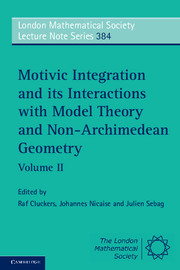Book contents
- Frontmatter
- Contents
- List of contributors
- Preface
- 9 Heights and measures on analytic spaces. A survey of recent results, and some remarks
- 10 C-minimal structures without density assumption
- 11 Trees of definable sets in ℤp
- 12 Triangulated motives over noetherian separated schemes
- 13 A survey of algebraic exponential sums and some applications
- 14 A motivic version of p-adic integration
- 15 Absolute desingularization in characteristic zero
- References
10 - C-minimal structures without density assumption
Published online by Cambridge University Press: 07 October 2011
- Frontmatter
- Contents
- List of contributors
- Preface
- 9 Heights and measures on analytic spaces. A survey of recent results, and some remarks
- 10 C-minimal structures without density assumption
- 11 Trees of definable sets in ℤp
- 12 Triangulated motives over noetherian separated schemes
- 13 A survey of algebraic exponential sums and some applications
- 14 A motivic version of p-adic integration
- 15 Absolute desingularization in characteristic zero
- References
Summary
A C-relation is the ternary relation induced by a meet-semi-lattice tree on the set of its branches, namely: C(x; y, z) if the intersection of x and z is strictly contained in the intersection of y and z. An ultrametric distance, in particular a valuation on a field, defines a C-relation: C(x; y, z) iff d(x, y) < d(y, z). A C-structure is a set equipped with a C-relation and possibly additional structure. Automorphism groups were the original motivation, in the middle of the 80's, of model theorists who considered C-structures, as C-relations provide natural examples of 2-homogeneous structures. Initially there was no connection with stability theory, another area from model theory, which can be considered to have started with an article of Michael Morley published in 1965, and has developed vigorously and continuously since then.
At the same time (around 1985), it was noticed by several people, including van den Dries, Knight, Pillay, Steinhorn, that some techniques from stability theory could be carried out in structures which are definitely not stable, namely certain linearly ordered (infinite) structures, that they called o-minimal (“o” for “order”). About ten more years were needed before Haskell, Macpherson and Steinhorn introduced dense C-minimal structures and described a common framework which comprised both strongly minimal structures (the simplest among stable structures), o-minimal structures and C-minimal structures. These are all structures which are characterized by the fact that definable sets in one-space (in one variable) are very simple.
- Type
- Chapter
- Information
- Motivic Integration and its Interactions with Model Theory and Non-Archimedean Geometry , pp. 51 - 86Publisher: Cambridge University PressPrint publication year: 2011
References
- 4
- Cited by

